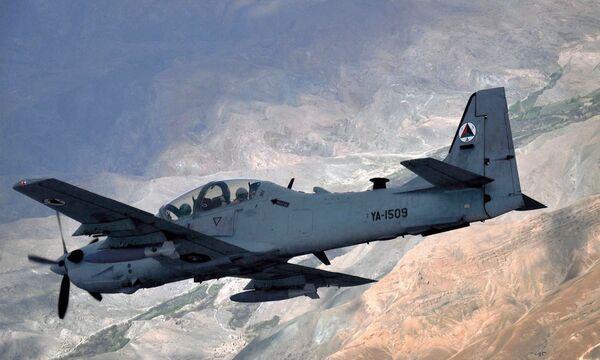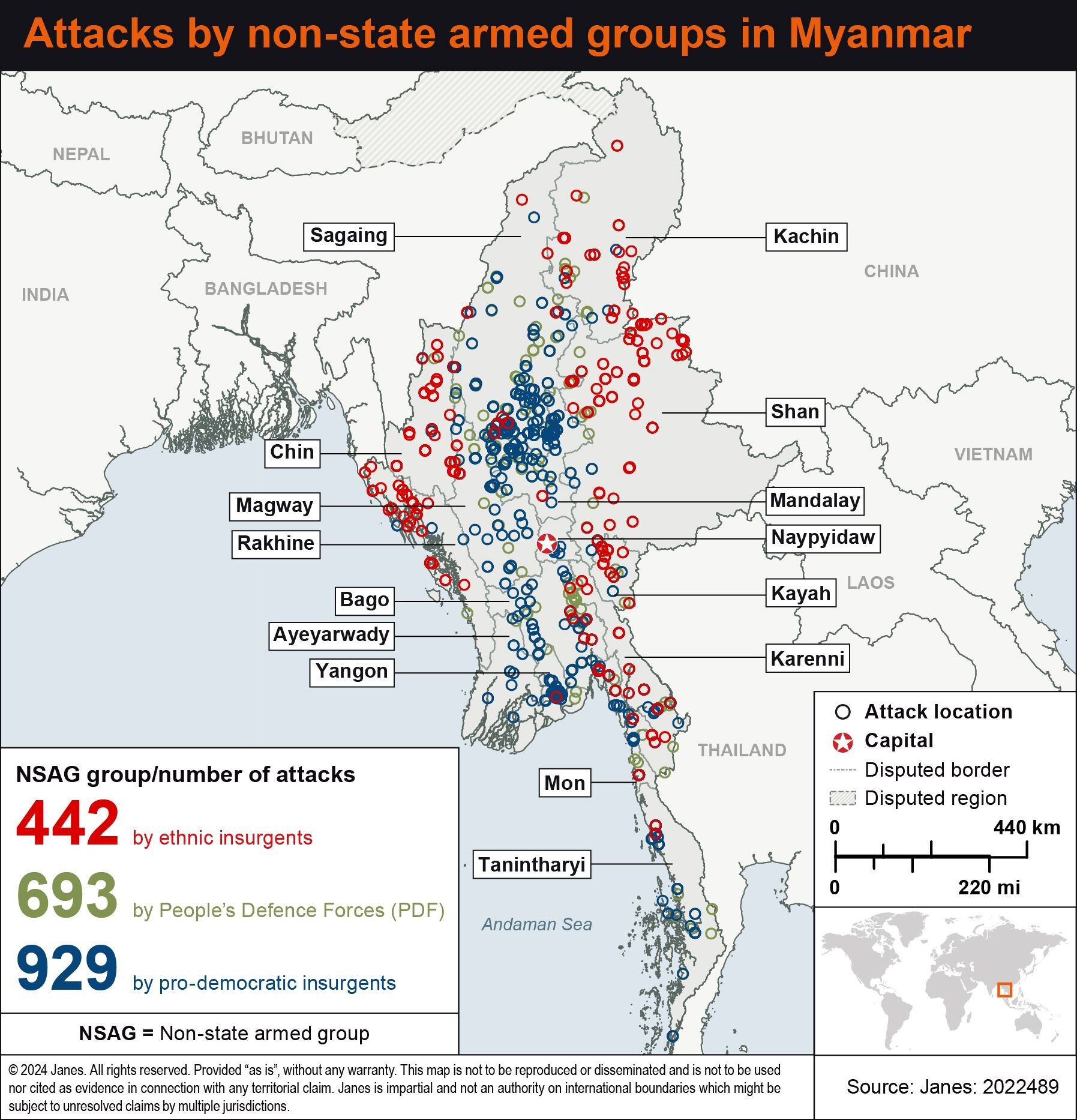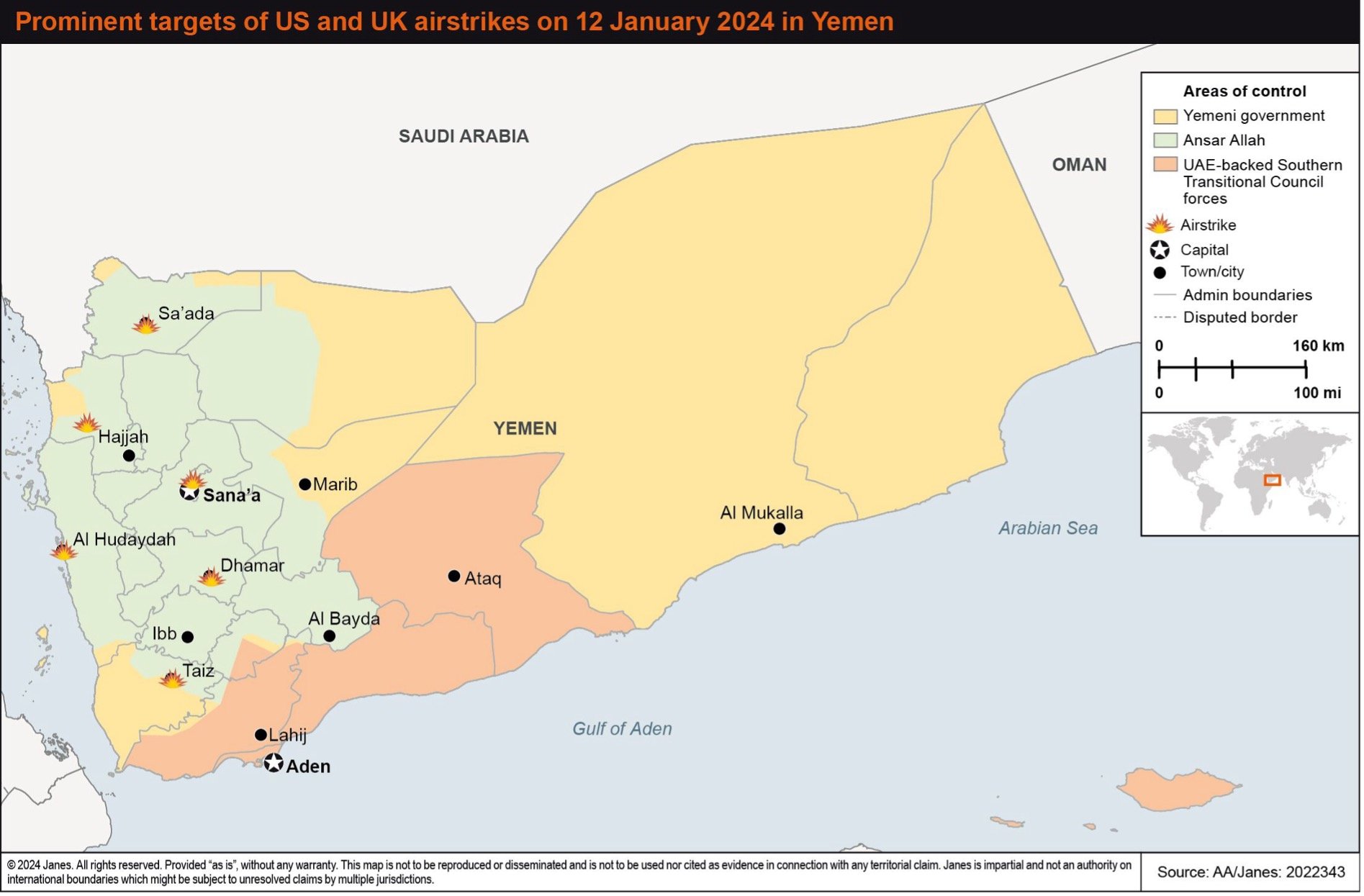- About
- Intara
- Capabilities
- Advisory
- Resources
- News
- Store
Dozens of Afghan Air Force aircraft flown out of Afghanistan
18 August 2021
by Tim Ripley
More than 40 Afghan Air Force (AAF) aircraft have been flown to Uzbekistan to prevent them from falling in the hands of the Taliban after the group regain control over Afghanistan on 15 August.
The arrival of the platforms at Termez Airport in southern Uzbekistan was reported by local media on 16 August, with commercial satellite imagery of the site subsequently confirming the relocation of a significant part of the AAF's fleet. Nearly 600 Afghans were reported as being aboard the aircraft and to be seeking asylum in Uzbekistan.

An Afghan Air Force (AAF) A-29B Super Tucano light attack aircraft. More than 40 AAF aircraft have been flown to Uzbekistan to prevent them from falling in the hands of the Taliban after the group regain control over Afghanistan on 15 August. (USAF 438th Air Expeditionary Wing)
Myanmar: Quarterly update, February 2024
27 March 2024
Date Posted: 11-Mar-2024
Author: Vaibhav Sharma, Bangalore Urmila Narzary, Bangalore Nidhi Dalal, Bangalore
Publication: Jane's Intelligence Review
Key points
- The Brotherhood Alliance launched co-ordinated attacks on military positions in Shan State, leading to a deteriorating security situation, social instability, and the displacement of thousands in the region
- On 12 January China brokered a ceasefire agreement between the Myanmar junta and the ethnic armed organisations, termed as ‘Haigeng Agreement' by the Brotherhood Alliance. However, the alliance accused the junta of ceasefire violation on 16 January
- Janes assesses that the tension between the NSAGs and the military is highly likely to continue until June
- Janes also assesses that the conflict has the potential to augment the refugee crisis in the region, as most of the Burmese try to flee to the neighbouring countries
Background
On 27 October 2023 a group of three ethnic armed organisations known as the ‘Brotherhood Alliance', consisting of the Arakan Army (AA), Ta'ang National Liberation Army (TNLA), and Kokang Myanmar National Democratic Alliance Army (MNDAA), conducted armed attacks against military positions in the northern parts of Shan State. The group launched ‘Operation 1027' to achieve its primary objective of safeguarding civilians, maintaining control over territory, and responding to ongoing artillery and airstrikes carried out by the military since February 2021. The operation also aimed to eradicate cyber-scam syndicates in the Kokang region, also known as Shan State Special Region 1, which are mainly operated by the Chinese-organised and allied militia groups based in Myanmar. Other militant groups, mainly the Kachin Independence Army (KIA) and the People's Defence Force (PDF), also joined the operation. The National Unity Government (NUG), the shadow government in Myanmar, welcomed the operation and vowed to collaborate with the Brotherhood Alliance to achieve its goal.
Between 30 October and 6 November 2023 clashes continued in 10 locations across Shan State, and the alliance, along with the PDF took control of 106 junta outposts, including the trade hub of Chinshwehaw. At least 100 soldiers were killed and many injured and arrested during this period. Large stocks of weapons and ammunition, including up to six tanks and armoured vehicles, were seized, according to a report by Irrawaddy, a local independent news website, on 11 November. At least 90,000 people have been displaced in northern Shan State and the Sagaing Region since the operation started on 27 October, according to a 9 November report by the United Nations' (UN's) Office for the Coordination of Humanitarian Affairs (OCHA).

Attacks by NSAGs in Myanmar from 1 January 2023 to 14 February 2024. (Janes)
Outlook
Janes assesses that the clashes between the military junta and EAOs, especially the Brotherhood Alliance, are highly likely to continue until June 2024 as the EAOs try to gain more territorial control and the military junta tries to regain the lost territories. The conflict has the potential to augment the existing refugee crisis in the region, as most Burmese citizens try to flee to the neighbouring countries. This was evident after the announcement of mandatory military conscription; the embassies in Myanmar were crowded with people trying to flee the country.
According to Stockholm International Peace Research Insititute (SIPRI), Russia was the major exporter of arms to Myanmar in 2022, followed by China. Along with arms exports, China has significant infrastructure investments in Myanmar and supports the EAOs with weapons supplies. While Western countries, including the UK, the US, and the EU member states continue to impose further sanctions on Burmese individuals and companies, Myanmar's proximity with China and Russia is likely to increase.
Inauguration of Guatemala's new president culminates a period of high tension and uncertainty
19 January 2024
Date Posted: 17-Jan-2024
Publication: Jane's Intelligence Review
Guatemala has inaugurated a new president after a complicated election process. Janes examines the delays in the official ceremony and the factors behind the country's tensions over the past six months
Key points
- Guatemala's new President Bernardo Arévalo faced delays in being sworn in, throwing uncertainty over the transfer of power after a complex election period
- The outgoing Congress and the Attorney General's Office brought instability and uncertainty to the transfer of power, with the Constitutional Court of the Supreme Court of Justice acting as counterweight protecting Guatemala's constitutional order
- As long as the current Attorney General's Office remains in office, it is very likely that the institution will actively seek to attack the president, his close allies, and members of the party
Transfer of Power
The inauguration of Guatemala's President Bernardo Arévalo on 14 January culminated a drawn-out electoral process marked by social and political instability. The inauguration took place in a context of uncertainty and tension over the possibility that the transfer of power would not take place after a complex electoral period.
According to Guatemala's constitution, the inauguration had to be held no later than 1600 h local time on 14 January. In the end, Arévalo was sworn in eight hours after this deadline had passed. The delay was attributed by the new members of Congress, allied to Arévalo, to the outgoing Congress' intention to hinder the transfer of legislative and executive powers. For a new president to be sworn in, the members of the new Congress must first be sworn in, then the new Congress must establish the new governing board, or junta directiva, which is responsible for conducting the handover of power so that the new president can be sworn in. Delays in each of these steps resulted in the delay to Arévalo being sworn in.
The chain of delays preceding the inauguration occurred as follows:
- Delays in the swearing in of the new Congress by the outgoing Congress: According to deputy-elect Román Castellanos in an interview with the Associated Press on 14 January, the swearing-in of new members of Congress was delayed because the outgoing commission took too long to assess the new deputies' credentials, and he alleged that the commission was “asking for requirements not established in the law in order to take office”, without specifying what requirements he was referring to. Once the process was completed, the debate on the new governing board began.
- Suspension of Movimiento Semilla party members in Congress: The second delay was caused by the decision of the outgoing Congress on the morning of 14 January to declare all members of Arévalo's party – Movimiento Semilla – as independents. This is because on 2 November 2023 the Citizens' Registry suspended the legal status of Movimiento Semilla for a second time, alleging irregularities in the party's official registration process. Although the suspension did not cancel the party's registration, it meant that the party could not conduct administrative tasks, such as sitting on the governing board. This led to a dispute between lawmakers over the formation of the new governing board, resulting in the temporary suspension of the process.
- Suspension overturned: Once the process had resumed, and all the new deputies had been sworn in, the new Congress decided to overturn the decision of the outgoing Congress and reinstate the Movimiento Semilla deputies, approving a motion to recognise the party as a legislative bloc. This allowed the formation of the new governing board for the period 2024–25 and, consequently, the transfer of power to Arévalo as president and Karin Herrera as vice-president.
During the eight-hour delay, demonstrations led by Arévalo supporters took place outside Congress. Meanwhile, the secretary general of the Organization of American States (OAS), Luis Almagro, in an improvised press conference in Guatemala City, read to the press a joint declaration signed by heads of state, foreign ministers, and senior officials of other governments attending the inauguration, calling on Congress to hand over power to Arévalo and Herrera.

Members of Congress argue during the session to elect the governing board, or junta directiva, before the inauguration ceremony of Guatemala's President-elect Bernardo Arévalo in Guatemala City on 14 January 2024. (María José Bonilla/AFP via Getty Images)
Electoral process
Since the first round of voting took place on 25 June 2023, the whole electoral process has been marked by social and political instability. Although the voting in both rounds was conducted in a transparent and organised manner, despite some isolated incidents of violence, it was the state institutions that brought instability and uncertainty to the process. In particular, judicial institutions such as the Attorney General's Office and the Special Prosecutor's Office against Impunity (Fiscalía Especial Contra la Impunidad: FECI), but also at one point, the presidency of the Supreme Court of Justice, obstructed the process in the periods before and after the voting days, while the Supreme Electoral Tribunal (Tribunal Supremo Electoral: TSE) and the Constitutional Court of the Supreme Court of Justice acted as counterweights, guaranteeing the protection of the results of the two rounds of voting, and of the constitutional order.
Since the TSE announced in June 2023 that the second round would take place between Arévalo and Sandra Torres, often referred by Guatemalan press as the candidate of the ruling political establishment, the risk of instability in Guatemala has been heightened by the actions of the Attorney General's Office and the FECI, both of which have opened investigations into the electoral process, suspended the registration of the Movimiento Semilla party twice, and raided the TSE headquarters, taking official records of the first-round results.
The most recent attempts of the Attorney General's Office to block Arévalo's ascension to the presidency took place on 16 November 2023, when the Public Prosecutor's Office accused Arévalo and Herrera of allegedly committing crimes during their participation in a demonstration at the University of San Carlos in 2022. On 16 November the Attorney General's Office announced that it had requested Arévalo and Herrera be stripped of their immunity on charges of aggravated misappropriation, destruction of cultural property, and illicit association. On 14 December the Constitutional Court granted a definitive appeal, known as amparo, against the prosecution's case against Arévalo and Herrera to “safeguard the constitutional order” and with the “ultimate aim of preserving the rule of law”.
The actions of the judicial institutions led to nationwide protests towards the end of 2023 by citizens demanding the resignation of Attorney General Consuelo Porras, FECI head Rafael Curruchiche, and judges Fredy Orellana and Cinthia Monterroso.
US and UK airstrikes against Ansar Allah unlikely to deter future attacks on Red Sea shipping
16 January 2024
Date Posted: 12-Jan-2024
Author: James Trigg, London
Publication: Jane's Country Risk Daily Report
Key points
- Event: US and UK forces launched a series of airstrikes against Ansar Allah on 12 January, targeting the group's capability to launch UAVs and missiles
- Significance: These strikes also came after Ansar Allah launched its largest barrage of missiles and UAVs to date towards the Red Sea on 9 January, deliberately targeting a US warship for the first time
- Outlook: Ansar Allah will almost certainly seek to respond with further missile and UAV attacks targeting the Red Sea in the immediate term, dependent on the damage inflicted by the 12 January airstrikes. The risk of escalating the conflict means international and regional support for further airstrikes will likely be limited
Event
At approximately 0230 h local time, the US and the UK launched a series of air and missile strikes against targets in Ansar Allah-controlled Yemeni territory. In an 11 January statement (Eastern Standard Time) acknowledging the operation, US Air Force Lieutenant General Alexus Grynkewich reported that the strikes occurred at “over 60 targets at 16 … sites”. The strikes were carried out through a combination of Tomahawk cruise missiles launched by US Arleigh Burke-class destroyers and a US submarine in the Red Sea, as well as aircraft deployed from the USS Dwight D. Eisenhower and RAF Akrotiri in Cyprus.
According to a 12 January statement by US Central Command (CENTCOM), the purpose of the strikes was “to degrade [Ansar Allah's] capability to continue their illegal and reckless attacks on US and international vessels and commercial shipping in the Red Sea”. The strikes targeted locations and infrastructure associated with Ansar Allah's unmanned aerial vehicle (UAV) and missile inventories, including “radar systems, air-defence systems, and storage and launch sites”. A 12 January statement by the British Ministry of Defence (MoD) outlined two target sites. One was “a site at Bani … used to launch reconnaissance and attack drones” while the other site was “the airfield at Abbs”.
In a 12 January statement, the spokesperson for the Yemeni armed forces aligned with Ansar Allah, Brigadier General Yahya Sare'e, acknowledged that the strikes had hit the Yemeni capital, Sana'a, along with “the governorates of [Hudaydah], Taiz, Hajjah, and Sa'ada”, resulting in five fatalities and six injured.

Prominent targets of US and UK airstrikes on 12 January 2024 in Yemen. (Janes)
For more detail on weapons systems and military assets used by US and UK forces, please see:
Significance
The operation followed the passage of a UN Security Council (UNSC) resolution on 10 January, which condemned “in the strongest terms” Ansar Allah's campaign of attacks on merchant and commercial vessels in the Red Sea. The resolution also took note of “the right of Member States, in accordance with international law, to defend their vessels”.
These strikes also came after Ansar Allah launched its largest barrage of missiles and UAVs to date towards the Red Sea on 9 January. According to a US CENTCOM statement from the same day, “eighteen [one way attack] UAVs, two anti-ship cruise missiles, and one anti-ship ballistic missile” were launched towards vessels in the Southern Red Sea. These were all intercepted by F/A-18 Super Hornets from USS Dwight D. Eisenhower , the Arleigh-Burke class USS Gravely , USS Laboon , USS Mason , and the UK Royal Navy's HMS Diamond .
Furthermore, the 9 January attack was the first since Ansar Allah began attacks against Red Sea shipping on 19 November 2023 that the Yemeni group had deliberately targeted warships operating in the theatre. In a 10 January statement, Brig Gen Sare'e reported that the 9 January operation targeted “a US ship that was providing support for [Israel]”.
Outlook
Before the airstrikes occurred, Ansar Allah's messaging had carried a defiant tone. In an 11 January speech on Al-Masirah TV, Ansar Allah's leader Abdul Malik Al‐Houthi warned that the group's response to any attack by the US would “not only be as significant as the operation carried out [on 9 January] with more than 24 drones and several missiles, it will be even bigger”, according to an 11 January report by BBC Monitoring.
Brig Gen Sare'e also threatened that “American and British … aggression … will not go unanswered and unpunished” in his 12 January statement following the airstrikes. A further statement by the Ansar Allah's Supreme Political Council (SPC) warned that “all American-British interests have become legitimate targets” as a result of the airstrikes. Janes assesses that Ansar Allah will almost certainly seek to respond with further missile and UAV attacks targeting the Red Sea in the immediate term, a timeframe dependent on the level of damage inflicted by the 12 January airstrikes and the time required for Ansar Allah to recover.
Coming in the aftermath of the 10 January UNSC resolution, the US CENTCOM statement regarding the airstrikes stressed the international backing for the operation, specifically “support from Australia, Canada, the Netherlands, and Bahrain”. However, Janes assesses that international and regional support for further airstrikes will likely be limited. This will be particularly true of Saudi Arabia, which continues to seek a peace agreement with Ansar Allah following nine years of conflict. In a 12 January statement, the Saudi Ministry of Foreign Affairs called for “self-restraint and avoiding escalation”.
While the British Secretary of State for Defence, Grant Shapps, stated in a 10 January press conference that the UK, its Western allies, and Saudi Arabia “were all agreed” that Ansar Allah attacks on Red Sea shipping could not continue, Janes assesses that Riyadh will almost certainly be concerned that any escalation in the conflict between Ansar Allah and the coalition of nations operating in the Red Sea risks a resumption in attacks by Ansar Allah against the kingdom.
On 5 December 2023 a member of Ansar Allah's Political Bureau, Mohammed Al-Bukhaiti, issued a warning for both Saudi Arabia and the United Arab Emirates (UAE). In an interview with France 24 Arabic, Bukhaiti stated that if Riyadh and Abu Dhabi act to protect Israel, then “Yemen will destroy their oil facilities and attack oil ships”. Janes assesses that, conscious of these threats, Saudi Arabia will be cautious about being associated with statements regarding future actions by the US and UK against Ansar Allah, as they are likely to risk escalating the conflict, jeopardising the ongoing peace negotiations between Riyadh and Ansar Allah, and only prolonging the risk to Red Sea shipping.
(Note: Items from news/wire services are abstracted from the originals and are not verbatim)
More than 40 Afghan Air Force (AAF) aircraft have been flown to Uzbekistan to prevent them from fall...
Latest Podcasts
Iran Israel analysis
In this podcast Janes analysts discuss the Iranian attacks on Israel on the 14 April. They highlight the military systems used by Iran and the performance and impact of these on Israel. They also discuss the implications of this attack goi...
Listen nowJanes Case Studies
Using Janes Intara to build a common intelligence picture: Russian build up on the Ukrainian border
View Case StudyNews Categories
 Security Details
Security Details 